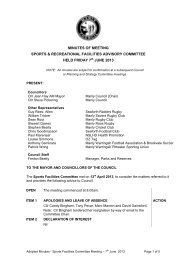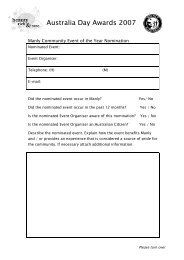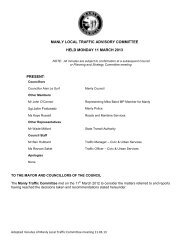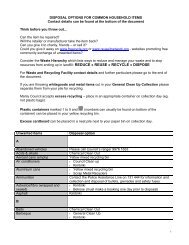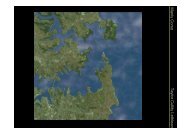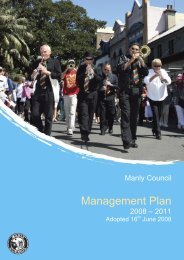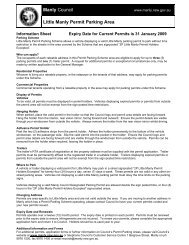Manly Lagoon Dredging Project - Manly Council - NSW Government
Manly Lagoon Dredging Project - Manly Council - NSW Government
Manly Lagoon Dredging Project - Manly Council - NSW Government
- No tags were found...
Create successful ePaper yourself
Turn your PDF publications into a flip-book with our unique Google optimized e-Paper software.
<strong>Manly</strong> <strong>Lagoon</strong> <strong>Dredging</strong> <strong>Project</strong> – Review of Environmental FactorsPrepared for <strong>Manly</strong> and Warringah <strong>Council</strong>sIn the initial consultation letters (Appendix B) and the associated replies and the trialdredging report (Cardno Ecology Lab, 2009c, Appendix C), the dredging is referred to asbeing at two sites (Site 1 and 2). For the purposes of this REF, the sites have beenamalgamated and are referred to as the ‘dredge area’.The proposed dredging works within <strong>Manly</strong> <strong>Lagoon</strong> extend from the footbridge at NolanReserve downstream to the end of Riverview Parade, as shown in Figure 2.1. It is intendedthat all removed sediment will be treated, tested, and depending on the final chemical andphysical composition, beneficially reused. The actual locations at which material will bereused is currently being considered and evaluated in a parallel process. It should be notedthat due to the nature of the material (potentially containing acid sulfate soils and otherwaste) and the method with which it will be processed (via dosing and dewatering), thematerial cannot be classified as Virgin Excavated Natural Material (VENM), as defined bythe PoEO Act. This will affect where the material can be reused, however this beneficialreuse is not assessed in this REF. If testing determines that the material is not suitable forreuse it will be disposed of appropriately to landfill.Calculations and dredging plans (Appendix J) show that 97% of material to be removed willbe from the upper 1m of the lagoon bed with the remaining 3% being from the 1 to 1.2mdepth range.2.5.1 Methodology for Proposed WorksThe proposed methodology for the removal and treatment of <strong>Manly</strong> <strong>Lagoon</strong> sediments isdiscussed below: Primary silt curtains will be installed approximately 25m upstream and downstream ofthe area where dredging works are taking place to prevent the movement of anydisturbed silt outside the area. Following discussion with I&I <strong>NSW</strong>, it has been agreedthat these will be across the full profile of the lagoon and will remain in place untildredging works have been completed and TSS levels in the area have fallen below50 mg/L. A secondary silt curtain will be installed downstream of the proposed worksto provide protection in the event of a failure in the primary silt curtain. Large items such as plastic bottles, cans, and shopping trolleys will be removed fromthe lagoon bed. These items will be moved to skips on the lagoon bank and recycledwhere practical or disposed of appropriately. Sediment will be removed from the lagoon using a diesel-powered cutter suctiondredger (which is noted as the preferred method of dredging by I&I <strong>NSW</strong> (Fisheries))(Section 3.2). An initial ‘calibration period’ of dredging, demonstrating satisfactoryoperation of all equipment and mitigation measures must be satisfactorily completedbefore full scale dredging is instigated (Section 2.6); The dredger will be mobile within the lagoon, and will bring sediment from the lagoonbed to the surface through a flexible pipe, connected to the suction head. <strong>Dredging</strong> isexpected to take around 30 days. To minimise turbidity within the lagoon, no cuttingactivity will be undertaken without the suction head being operative.2 July 2010 Cardno (<strong>NSW</strong>/ACT) Pty Ltd 11H:\Doc\2010\Reports.2010\Rep2580v4.doc



